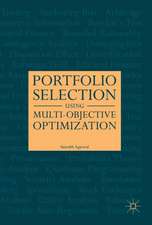Introduction to Quantitative Methods for Financial Markets: Compact Textbooks in Mathematics
Autor Hansjoerg Albrecher, Andreas Binder, Volkmar Lautscham, Philipp Mayeren Limba Engleză Paperback – 24 iul 2013
In particular, the exposition is tailored for classroom use in a Bachelor or Master program course, as well as for practitioners who wish to further strengthen their quantitative background.
Din seria Compact Textbooks in Mathematics
-
 Preț: 540.11 lei
Preț: 540.11 lei -
 Preț: 422.90 lei
Preț: 422.90 lei -
 Preț: 281.15 lei
Preț: 281.15 lei -
 Preț: 356.49 lei
Preț: 356.49 lei -
 Preț: 319.43 lei
Preț: 319.43 lei - 20%
 Preț: 300.32 lei
Preț: 300.32 lei -
 Preț: 421.93 lei
Preț: 421.93 lei - 20%
 Preț: 339.32 lei
Preț: 339.32 lei -
 Preț: 359.81 lei
Preț: 359.81 lei -
 Preț: 348.39 lei
Preț: 348.39 lei -
 Preț: 585.27 lei
Preț: 585.27 lei -
 Preț: 452.83 lei
Preț: 452.83 lei -
 Preț: 350.72 lei
Preț: 350.72 lei - 15%
 Preț: 466.13 lei
Preț: 466.13 lei -
 Preț: 445.43 lei
Preț: 445.43 lei -
 Preț: 356.49 lei
Preț: 356.49 lei -
 Preț: 486.03 lei
Preț: 486.03 lei -
 Preț: 427.33 lei
Preț: 427.33 lei -
 Preț: 382.57 lei
Preț: 382.57 lei -
 Preț: 348.22 lei
Preț: 348.22 lei -
 Preț: 356.49 lei
Preț: 356.49 lei -
 Preț: 356.49 lei
Preț: 356.49 lei -
 Preț: 184.33 lei
Preț: 184.33 lei -
 Preț: 354.93 lei
Preț: 354.93 lei -
 Preț: 314.21 lei
Preț: 314.21 lei -
 Preț: 389.70 lei
Preț: 389.70 lei -
 Preț: 378.21 lei
Preț: 378.21 lei -
 Preț: 315.18 lei
Preț: 315.18 lei -
 Preț: 389.70 lei
Preț: 389.70 lei -
 Preț: 388.90 lei
Preț: 388.90 lei -
 Preț: 348.98 lei
Preț: 348.98 lei -
 Preț: 320.84 lei
Preț: 320.84 lei -
 Preț: 324.01 lei
Preț: 324.01 lei -
 Preț: 414.72 lei
Preț: 414.72 lei -
 Preț: 385.10 lei
Preț: 385.10 lei -
 Preț: 414.04 lei
Preț: 414.04 lei -
 Preț: 356.31 lei
Preț: 356.31 lei -
 Preț: 447.41 lei
Preț: 447.41 lei -
 Preț: 316.71 lei
Preț: 316.71 lei -
 Preț: 381.81 lei
Preț: 381.81 lei -
 Preț: 482.74 lei
Preț: 482.74 lei
Preț: 494.85 lei
Preț vechi: 582.18 lei
-15% Nou
Puncte Express: 742
Preț estimativ în valută:
94.73€ • 97.48$ • 79.85£
94.73€ • 97.48$ • 79.85£
Carte tipărită la comandă
Livrare economică 01-15 martie
Preluare comenzi: 021 569.72.76
Specificații
ISBN-13: 9783034805186
ISBN-10: 3034805187
Pagini: 206
Ilustrații: IX, 191 p. 48 illus., 10 illus. in color.
Dimensiuni: 155 x 235 x 15 mm
Greutate: 0.3 kg
Ediția:2013
Editura: Springer
Colecția Birkhäuser
Seria Compact Textbooks in Mathematics
Locul publicării:Basel, Switzerland
ISBN-10: 3034805187
Pagini: 206
Ilustrații: IX, 191 p. 48 illus., 10 illus. in color.
Dimensiuni: 155 x 235 x 15 mm
Greutate: 0.3 kg
Ediția:2013
Editura: Springer
Colecția Birkhäuser
Seria Compact Textbooks in Mathematics
Locul publicării:Basel, Switzerland
Public țintă
Upper undergraduateCuprins
I Interest Rates.- II Financial Products.- III The No-Arbitrage Principle.- IV European and American Options.- The Binomial Option Pricing Model.- VI The Black-Scholes Model.- VII The Black-Scholes Formula.- VIII Stock-Price Models.- IX Interest Rate Models and the Valuation of Interest Rate Derivatives.- X Numerical Tools.- XI Simulation Methods.- XII Calibrating Models – Inverse Problems.- XIII Case Studies: Exotic Derivatives.- XIV Portfolio-Optimization.- XV Introduction to Credit Risk Models.
Recenzii
From the reviews:
“The aim of this book is twofold. Firstly to equip the reader with the fundamental mathematical skills associated with modern finance and secondly to relate these skills to practical outcomes. … It is written as an introductory text for senior undergraduates or early graduate students with a reasonable background in mathematics. … For the interested reader references are provided if they wish to further enrich their knowledge. Also, at the end of each chapter a number of beneficial exercises are provided.” (John O’Hara, zbMATH, Vol. 1273, 2013)
“The aim of this book is twofold. Firstly to equip the reader with the fundamental mathematical skills associated with modern finance and secondly to relate these skills to practical outcomes. … It is written as an introductory text for senior undergraduates or early graduate students with a reasonable background in mathematics. … For the interested reader references are provided if they wish to further enrich their knowledge. Also, at the end of each chapter a number of beneficial exercises are provided.” (John O’Hara, zbMATH, Vol. 1273, 2013)
Notă biografică
Hansjoerg Albrecher is Professor of Actuarial Science at the Faculty of Business and Economics, University of Lausanne, as well as a Faculty Member of the Swiss Finance Institute. Previous affiliations include the Johann Radon Institute for Computational and Applied Mathematics of the Austrian Academy of Sciences in Linz, the University of Linz, the University of Aarhus, K.U. Leuven and Graz University of Technology. The author has ample experience in connecting the academic world with practitioners' views and problems, and has been advising banks and insurance companies.
Andreas Binder is CEO of MathConsult GmbH and head of MathConsult's computational finance group, who have been developing the UnRisk® software suite for valuation and risk management of financial instruments. He is an experienced adviser of banks, auditors, regulators and capital management firms.
Volkmar Lautscham has graduated in Technical Mathematics and Financial/Industrial Management from Graz University of Technology and Karl-Franzens University, respectively, with longer academic stays abroad in Sheffield, London and Stockholm. From 2006 to 2009, he was working for a major investment bank in London focusing on credit underwriting/structuring and real estate. The author currently holds a position at the University of Lausanne, where he pursues a PhD degree and teaches within the MSc Actuarial Science programme.
Philipp Mayer obtained his PhD in financial mathematics from Graz University of Technology. He then held amongst others a post-doc position at the Radon Institute of the Austrian Academy of Sciences in Linz, before returning to Graz as an assistant professor, where he carried out research in financial mathematics and taught both bachelor and master level courses. In 2010 he joined the Financial Markets department of a major financial institution in Brussels, where he is responsible for modeling equity, commodity and hybridinstruments.
Andreas Binder is CEO of MathConsult GmbH and head of MathConsult's computational finance group, who have been developing the UnRisk® software suite for valuation and risk management of financial instruments. He is an experienced adviser of banks, auditors, regulators and capital management firms.
Volkmar Lautscham has graduated in Technical Mathematics and Financial/Industrial Management from Graz University of Technology and Karl-Franzens University, respectively, with longer academic stays abroad in Sheffield, London and Stockholm. From 2006 to 2009, he was working for a major investment bank in London focusing on credit underwriting/structuring and real estate. The author currently holds a position at the University of Lausanne, where he pursues a PhD degree and teaches within the MSc Actuarial Science programme.
Philipp Mayer obtained his PhD in financial mathematics from Graz University of Technology. He then held amongst others a post-doc position at the Radon Institute of the Austrian Academy of Sciences in Linz, before returning to Graz as an assistant professor, where he carried out research in financial mathematics and taught both bachelor and master level courses. In 2010 he joined the Financial Markets department of a major financial institution in Brussels, where he is responsible for modeling equity, commodity and hybridinstruments.
Textul de pe ultima copertă
Swaps, futures, options, structured instruments - a wide range
of derivative products is traded in today's financial markets.
Analyzing, pricing and managing such products often requires
fairly sophisticated quantitative tools and methods. This book
serves as an introduction to financial mathematics with special
emphasis on aspects relevant in practice. In addition to numerous
illustrative examples, algorithmic implementations are demonstrated
using "Mathematica" and the software package "UnRisk" (available
for both students and teachers). The content is organized in 15
chapters that can be treated as independent modules.
In particular, the exposition is tailored for classroom use in a
Bachelor or Master program course, as well as for practitioners
who wish to further strengthen their quantitative background.
of derivative products is traded in today's financial markets.
Analyzing, pricing and managing such products often requires
fairly sophisticated quantitative tools and methods. This book
serves as an introduction to financial mathematics with special
emphasis on aspects relevant in practice. In addition to numerous
illustrative examples, algorithmic implementations are demonstrated
using "Mathematica" and the software package "UnRisk" (available
for both students and teachers). The content is organized in 15
chapters that can be treated as independent modules.
In particular, the exposition is tailored for classroom use in a
Bachelor or Master program course, as well as for practitioners
who wish to further strengthen their quantitative background.
Caracteristici
First volume of a new series Self-contained and compact introduction to financial mathematics and quantitative modeling of financial markets Covers a broad area, from a basic introduction to financial markets, products and concepts, via model development, up to the calibration of models to market data and implementation of pricing algorithms Leads the reader from standard derivatives to quite advanced recent exotic products Practical aspects and benefits of implementation techniques are discussed and illustrated using Mathematica and UnRisk (software available to readers) Ready for classroom use or self-study Provides many illustrative examples and exercises, some with solutions Includes supplementary material: sn.pub/extras

















